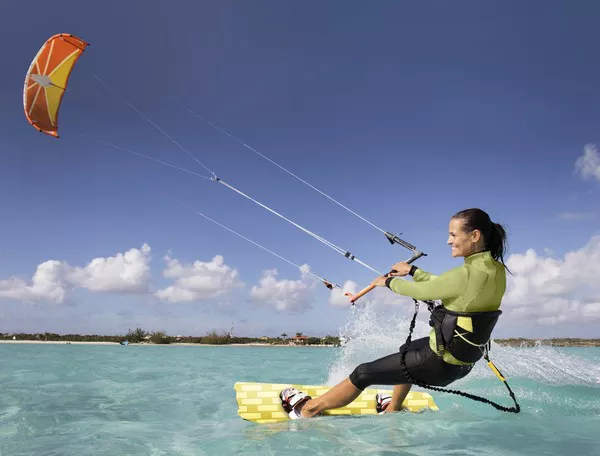Kitesurfing, a thrilling water sport that combines elements of surfing, wakeboarding, and kite flying, has captivated adventurers around the world. Riding the waves propelled by the wind offers a unique blend of adrenaline and serenity. However, like any extreme sport, it demands skill, knowledge, and safety awareness. This guide will delve into the fundamentals of kitesurfing, from equipment basics to riding techniques, enabling enthusiasts to embark confidently on this exhilarating journey.
Getting Started: Essential Equipment
Before hitting the water, aspiring kitesurfers must gather the necessary equipment. Here’s what you’ll need:
1. Kite: The kite is the heart of kitesurfing. Choose the right size based on wind conditions and your weight. Smaller kites (around 7-9 square meters) are ideal for high winds, while larger kites (12-17 square meters) suit lighter winds.
2. Control Bar: This is your interface with the kite. The control bar allows you to steer and control the kite’s power. Familiarize yourself with the bar’s safety features, including quick-release mechanisms.
3. Harness: Invest in a comfortable waist or seat harness to distribute the kite’s pull evenly across your body.
4. Board: Kitesurfing boards come in various shapes and sizes, designed for different riding styles. Beginners typically start with a larger, stable board.
5. Safety Gear: Don’t overlook safety. Wear a helmet, impact vest, and possibly a wetsuit depending on water temperature and personal preference.
Understanding Wind Conditions
Mastering kitesurfing begins with understanding wind dynamics. Start with moderate and consistent winds (12-20 knots) for safe practice. Avoid gusty or offshore winds, as they pose significant risks. Always check weather forecasts and wind conditions before heading out.
Basic Techniques: Launching and Landing
1. Setting Up: Lay out your lines away from obstacles. Attach the lines to the kite and secure the control bar.
2. Launching: With the help of a buddy, launch the kite from the edge of the wind window. Maintain tension on the lines to keep the kite stable.
3. Landing: When landing, steer the kite to the edge of the wind window and release the power using the safety system. Have a helper catch the kite to prevent it from relaunching.
Body Dragging: Building Foundation Skills
Before attempting to stand on the board, practice body dragging. This involves using the kite’s power to propel yourself through the water:
1. Downwind Drag: Keep the kite low in the wind window to pull yourself along the water’s surface.
2. Upwind Drag: Steer the kite up and across the wind window to generate lift and move against the wind.
Body dragging teaches kite control and prepares you for board riding.
Board Riding: Finding Your Feet
Transitioning from body dragging to board riding is a milestone. Here’s how to do it:
1. Water Start: With the kite at 12 o’clock, position the board on your feet. Steer the kite gently to generate pull and stand up on the board.
2. Edging: Learn to edge the board against the kite’s pull to control speed and direction.
3. Turning: Practice carving turns by shifting your weight and steering the kite.
Advanced Techniques: Riding Waves and Jumping
Once comfortable with basic riding, progress to more advanced maneuvers:
1. Wave Riding: Position the kite for power while navigating waves. Learn to adjust speed and direction to harness wave energy.
2. Jumping: Master controlled jumps by timing the kite’s pull against your board’s momentum. Start with small jumps and gradually increase height and complexity.
Safety Protocols: Prioritizing Well-being
Safety is paramount in kitesurfing:
1. Spot Assessment: Evaluate the launch site for hazards like rocks, boats, or other obstacles.
2. Self-Rescue: Learn self-rescue techniques, including using the kite as a sail to return to shore.
3. Weather Awareness: Stay informed about changing weather conditions. Avoid kitesurfing during storms or unstable weather.
Continued Progression: Learn and Grow
Kitesurfing is a journey of continual improvement. Take lessons from certified instructors to refine techniques and learn new skills. Join kitesurfing communities to exchange tips and experiences with fellow enthusiasts.
Conclusion
Kitesurfing embodies the perfect synergy of wind, water, and skill. Embrace the learning curve, prioritize safety, and enjoy the exhilaration of harnessing nature’s forces. With dedication and practice, you’ll unlock the full potential of this thrilling sport. So, grab your gear, heed the wind’s call, and embark on an adventure that will redefine your relationship with the elements.

